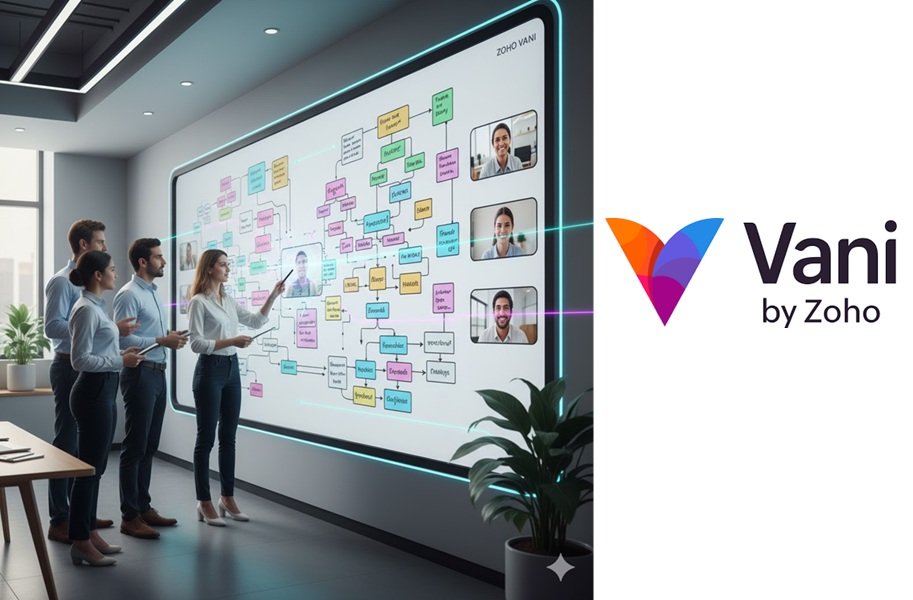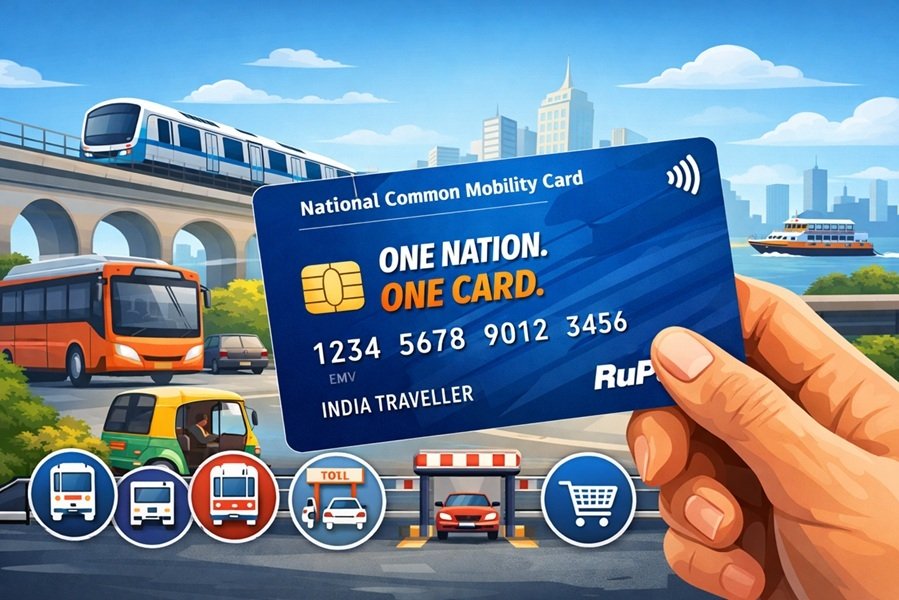
In an era where workplace tools are abundant yet disconnected, Zoho Corporation has stepped in with a bold, cohesive solution — Zoho Vani. Officially launched in late 2025, Vani isn’t just another whiteboard or productivity app. It’s a visual-first collaboration platform designed to unify the creative, planning, and execution phases of work in a single infinite canvas.
But what makes Vani more than a rebranded workspace? Let’s dive deep into what it is, how it works, and why it matters in the evolving ecosystem of digital productivity.
The Problem Vani Wants to Solve
Modern teams — especially remote or hybrid ones — suffer from a fractured digital landscape. You might brainstorm in one tool, run meetings in another, track tasks elsewhere, and design workflows in yet another. Each platform may be excellent on its own, but when stitched together, the result is clunky.
More tools often mean more context-switching, more learning curves, and more chaos.
Zoho Vani addresses this fragmentation by offering a single visual surface where teams can co-create ideas, hold meetings, design workflows, and assign tasks — all in one place. This is not merely convenience; it’s a shift in how people engage with work visually and collaboratively.
Inside Zoho Vani: A Visual Operating System for Teams
At its core, Vani is built around an infinite canvas, capable of hosting everything from sticky notes and diagrams to embedded videos, charts, spreadsheets, and live chat windows. But the architecture is more sophisticated than a giant blank slate.
1. Spaces and Zones: Organized Chaos
Vani introduces a smart structure with “Spaces” and “Zones.”
- Spaces act like large-scale containers for projects, campaigns, or any initiative.
- Zones are dedicated areas within a Space, allowing sub-teams (marketing, design, engineering, etc.) to work independently while staying visually connected.
This dual-layered system supports both parallel workflows and interconnected thinking. A marketing plan can live alongside product roadmaps, and financial models can sit adjacent to creative designs — all in harmony.
2. Visual Building Blocks
Vani isn’t limited to basic shapes and lines. It includes:
- Flowcharts, mind maps, wireframes, and architectural diagrams
- Sticky notes, text blocks, icons, custom shapes
- Embedded content from Zoho apps and third-party sources
- Pre-built templates (“kits”) for marketing plans, project tracking, user journeys, and more
These tools enable structured ideation — transforming the messy back-of-the-napkin ideas into formalized visual logic.
3. Built-In Audio & Video Calls
Unlike standalone whiteboards that rely on Zoom or Teams for communication, Vani includes native audio/video functionality. You can launch a call directly within a Space, share ideas in real time, annotate visuals live, and even record conversations that stay attached to the canvas.
This integration fosters true in-canvas collaboration — meetings and content are no longer separate silos.
4. AI That Assists, Not Replaces
Zoho Vani includes an embedded AI assistant designed to accelerate, not dominate your workflow. The AI can:
- Generate mind maps from raw notes
- Summarize discussions from meetings
- Suggest visuals or templates based on your input
- Help clean up or restructure complex visual layouts
Rather than overwhelming users with automation, Vani’s AI acts like a quiet partner — always ready to lend a hand but never in the way.
Use Cases That Matter
Zoho Vani isn’t just for tech teams or startups. Its versatility makes it suitable for a wide range of business scenarios:
✅ Startups Planning Product Launches
Visualize go-to-market strategies, timelines, user flows, and feature backlogs — all while discussing in real-time with your team.
✅ Marketing Teams Crafting Campaigns
Design cross-channel campaigns visually, map audience segments, and track performance — without needing a separate diagramming tool.
✅ Remote Teams Needing Virtual Whiteboards
Collaborate visually during online stand-ups, async planning, or deep brainstorming — with persistent, evolving workspaces.
✅ Project Managers Orchestrating Teams
Set up workflows visually, assign tasks, link dependencies, and watch your canvas evolve from idea to delivery.
✅ Educators and Trainers
Design course structures, visual learning modules, and collaborative assignments for students — all in one interactive surface.
Designed for the Underserved: SMBs and Beyond
One of the most strategic decisions behind Vani is accessibility. Zoho has intentionally priced the platform at ₹240/month in India (around $5 globally) — positioning it as an affordable yet powerful option for small and medium businesses.
In many emerging markets, SMBs have traditionally been excluded from premium productivity tools due to cost or complexity. Vani flips that dynamic by offering enterprise-level capabilities in a product that is intuitive and priced to scale.
The Bigger Picture: Zoho’s Ecosystem Play
Zoho Vani isn’t a standalone product. It’s part of Zoho’s broader vision to create an end-to-end operating system for businesses. From CRM and accounting to email, HR, and now visual collaboration, Zoho wants to be the central nervous system for modern companies.
Vani links tightly with other Zoho tools, offering a seamless experience for teams already in the ecosystem. For new users, it acts as a gateway — a visual-first entry point that can eventually lead to deeper integration.
What Makes Vani Different (and Better)?
While tools like Miro, FigJam, and Lucidchart dominate the visual collaboration market, Zoho Vani brings a few unique strengths to the table:
| Feature | Vani | Other Tools |
|---|---|---|
| Infinite Canvas + Structured Zones | ✅ Yes | ❌ Mostly flat canvases |
| Built-in Video Calls | ✅ Native | ❌ Often external integrations |
| Affordable for SMBs | ✅ ₹240/month | ❌ $10–$20+/month |
| Tight Integration with Business Apps | ✅ Zoho Suite Ready | ❌ Limited cross-app use |
| AI Assistant for Visual Work | ✅ Contextual Help | ⚠️ Varies |
| Privacy-Focused, No Ads | ✅ Zoho’s Data-First Ethos | ❌ Ad-driven or data-sharing |
This is not just a feature list — it’s a philosophy. Zoho Vani is built to be inclusive, intelligent, and intuitive.
Early Limitations and the Road Ahead
Despite its promise, Vani is still in its early innings. Some current limitations include:
- No mobile app yet (though it’s in development)
- Advanced project management features are still maturing
- Third-party integrations are limited compared to more mature platforms
- User adoption may require training or rethinking workflows
That said, Zoho has a track record of iterative development. With time, Vani is likely to expand in functionality, polish its UX, and support a wider set of use cases.
Future updates are expected to bring:
- Full mobile support
- Offline-first features
- Industry-specific templates
- Deeper AI integration
- More third-party app connectors
Final Thoughts: A Canvas with a Voice
Zoho Vani isn’t just another software tool — it’s a new way of working. By marrying the freeform creativity of whiteboarding with the structure of task management and the intelligence of AI, it represents a step forward in collaborative thinking.
More than anything, Vani is about breaking silos — between tools, teams, and ideas. It gives ideas a space to breathe, a place to grow, and a clear path to execution.
If you’ve ever felt your work was buried in files, lost in tabs, or trapped between platforms, Vani offers a fresh alternative: a place where your team can see the big picture, talk it through, and make it happen — all at once.
Suggested Articles
- What Is Zoho Corporation? India’s SaaS Pioneer Explained
- Zoho Show vs Microsoft PowerPoint: The Complete Comparison for 2025
- Zoho Sheets vs Microsoft Excel: A Detailed Comparison for 2025
- Zoho Writer vs MS Word: A Comprehensive Comparison for 2025
- Zoho Office Suite vs Microsoft Office: A Complete Comparison
- Arattai vs WhatsApp: A Detailed Comparison of Messaging Apps
- Zoho Mail vs Google Mail (Gmail): Detailed Comparison for 2025
- Aadi Vaani: India’s AI-Powered Platform to Preserve Tribal Languages





